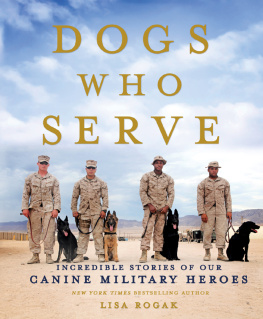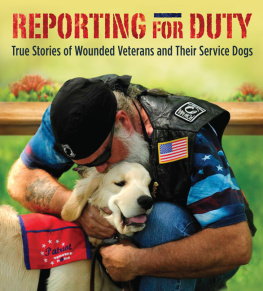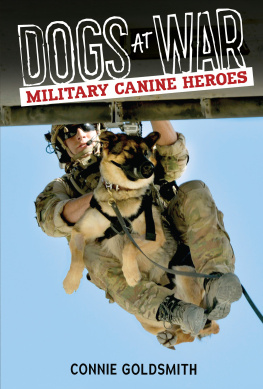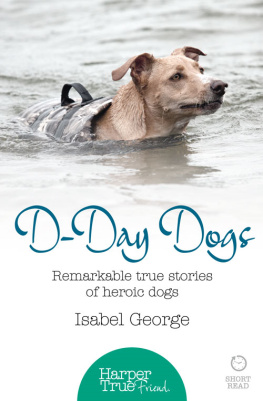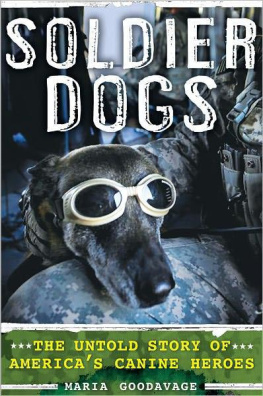Contents
Guide
DOGS
WHO SERVE
INCREDIBLE STORIES OF OUR CANINE MILITARY HEROES
LISA ROGAK
THOMAS DUNNE BOOKS

The author and publisher have provided this e-book to you for your personal use only. You may not make this e-book publicly available in any way. Copyright infringement is against the law. If you believe the copy of this e-book you are reading infringes on the authors copyright, please notify the publisher at: http://us.macmillanusa.com/piracy.
For all of the military journalists, photographers, and Public Affairs staffers who tell the stories of these brave canine soldiers and the men and women who work alongside them

Ever since May 2011, when the news first hit that there was a highly trained Belgian Malinois dog named Cairo who assisted a team of elite Navy SEALs in the raid that located and subsequently killed Osama bin Laden, people from all over have clamored for more information about the lives of the Military Working Dogs who serve in all branches of the U.S. military.
Though there have been countless stories and video news reports that have appeared in the years since the raid, people still cant get enough, whether its learning about the lives of MWDsshort for Military Working Dogsin wartime or the details about their constant training routines or what happens to them after they retire. Why do people love to hear stories about our canine soldiers? In short, because they represent everything that is great about the U.S. military. First of all, they serve a unique and specific purpose that no two-legged soldier could ever fill:
These dogs act as a first line of defense against enemy threats because they can smell things and go places that humans cant, said Tech. Sgt. Roseann Kelly, assistant flight chief with the 366th Security Forces Squadron at Mountain Home Air Force Base in Idaho.

Plus, their mere presence can have a huge effect even if they never bark or growl. Theyre a force multiplier, they give more power than just people alone, said S.Sgt. Samuel Giordano, a handler at RAF Mildenhall in the United Kingdom. The dogs are a huge psychological deterrent; people are often scared of them, and we use them for our own protection as well as force and resource protection.
Indeed, MWDs are often regarded as the last resort before a soldier decides to use deadly force. When you fire a weapon, you cant take that bullet back, said Cpl. Ryan Pilz, a handler based at Marine Corps Base at Camp Lejeune, North Carolina. These dogs are like our retractable bullets. A dog may chase after an enemy and attack him, but if the enemy surrenders or backs down, the dog can be called back.
But even though a canine soldier naturally serves as an effective weapon and crime deterrent, he needs a highly trained two-legged soldier to guide him.
A dog team is a special kind of asset, said Lance Cpl. Pete Hernandez, a handler with the 3rd Marine Expeditionary Force based in Okinawa, Japan. It relies on one handler building a bond with his partner. [Together] they can pinpoint where an odor is, tell explosive ordnance disposal Marines where to search, and if thats not available we can choose an alternate route and not have to put [Marines] in danger. I would definitely say that I put my life in my dogs hands.
While the dog has the nose, the handler is responsible for interpreting and serving as translator for other humans; as such, most handlers would add Canine Mind Reading to the long list of skills that are necessary to serve as the human side of an effective MWD team. You have to be able to read the dogs change in behavior and be able to control them, said S.Sgt. Randy Cottner, a military police dog handler. I know hes going to get sick before he gets sick.
While there are soldiers throughout the ranks that only see military working dogs as dogs, youd be hard-pressed to find a handler that feels this way, said Sgt. 1st Class Aaron Meier, kennel master with the 550th Military Working Dog Detachment at Fort Bragg, North Carolina. They become close, sometimes to an extent that it seems that they are one entity. In the end, a dog becomes an extension of the handler. Without one, the other is useless.

However, to develop that seamless connection, it usually requires weeks or months of long hours of training together and just hanging out. While some dogs and handlers instantly bond from the first moment of meeting, the reality is usually something different, and so the job of handler is not for the impatient.
It took three to six months to develop the type of bond I wanted with Kiara, said S.Sgt. Rosanne Caballero, an MWD trainer with the 799th Security Forces Squadron at Creech Air Force Base in Nevada. I spent a lot of time with her, got to know her, and she was with me everywhere I went while on duty. Theres more to this job [than people see] and its very time consuming. You have to want it. If your heart isnt set in it, then this job isnt for you.
As with any relationship that depends on being so closely attuned to your partner, trust is absolutely essential.
If the dog cannot trust you or you cannot trust the dog, there cannot be a rapport established and you will never become a team, said S.Sgt. Nicholas Drake, an MWD trainer with the 354th Security Forces Squadron at Eielson Air Force Base in Alaska. You will make mistakes and you have to be willing to let the dog make mistakes.
And the primary way they accomplish this trust is by letting a dog do dog things: walking around the base, jumping through the hoops and climbing ladders on the obstacle course, and chasing a ball or tugging on a rope for hours.
Both dog and human are obviously having a blast. But toss and fetch and the other games are actually bringing them together, to form a bond that will eventually help both to protect their fellow soldiers as well as each other when called upon to search for explosives and/or bad guys both at home and overseas.
It looks like play time for the dog and in a sense it is, said Tech. Sgt. Matthew Mosher, a handler who is also based out of Eielson Air Force Base. Everything needs to be fun for the dog and positive.
Once an MWD team achieves that bond, well, its hard to know where one begins and the other one starts; most MWDs are essentially a well-oiled machine where words are often not necessary.
When you achieve that level of rapport there is nothing that dog wont do for you, said Mosher. And once its achieved, its unbreakable.
At the same time, just like their human counterparts, canine soldiers each have their own distinctive personalities, and they can act differently with different people.
Imagine your M-4 [rifle], and now imagine your M-4 can communicate with you, and has good and bad days and a personality, said Capt. Jake Porter, the provost marshal at Forward Operating Base Spin Boldak in Afghanistan. Thats what handlers have to be able to deal with.

